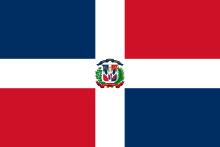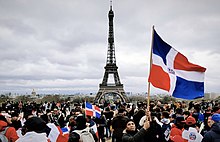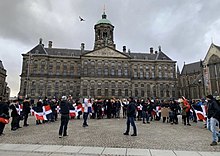

The Dominican diaspora consists of Dominican people and their descendants living outside of the Dominican Republic. Countries with significant numbers of Dominicans include the United States and Spain. These two nations have had historical ties to the Dominican Republic and thus it is the primary destination for many migrants. Many Dominicans migrate to the United States via Puerto Rico in rafts.
There are roughly 2.5 million people of Dominican ancestry living outside the Dominican Republic, mainly due to economic issues, greater education, and political stability.
Dominicans mostly started to migrate to the US and Spain after the assassination of Rafael Trujillo, the authoritarian dictator who ruled from 1930 to 1961.

History
The Dominican Republic originates from the Spanish colony of Santo Domingo, founded by Bartholomew Columbus, the brother of Christopher Columbus. The native peoples of Hispaniola, the Taino, an Arawak-speaking people, were completely wiped out due to diseases that the Spaniards brought from Europe. Nevertheless, today there are still some Dominicans with small amounts of Taino DNA, usually ranging from 5% to 10%.
Ethnic groups

Dominicans are predominantly mixed with European (specifically Spanish), African, and some indigenous Taino ancestry. Dominicans usually do not classify themselves as white or black like in the United States, but rather they identify with their nation, culture, and language.
Many Dominicans of predominantly European descent have ancestry from the Canary Islands and Andalucía, due to the immigration of people from these areas of Spain to Latin America. Dominican Spanish is similar to the Spanish spoken in these regions.
The majority of Dominicans have at least partial African ancestry, which comes from the Atlantic slave trade. The majority of the slaves came from West Africa and the Congo. There are also many Dominicans of Haitian descent who immigrated from Haiti or have parents or grandparents who immigrated.
References
- Batalova, Jeanne Batalova Erin Babich and Jeanne (2021-04-15). "Immigrants from the Dominican Republic in the United States". migrationpolicy.org. Retrieved 2021-09-25.
- Fitzpatrick, Patricia A. (2013). "Dominican Identity in Spain: Media Image as Legacy for the Second Generation". Afro-Hispanic Review. 32 (1): 31–44. ISSN 0278-8969. JSTOR 23617254.
- "Dominican Republic | International Organization for Migration". www.iom.int. Retrieved 2021-09-25.
- "Facts on Latinos of Dominican origin in the U.S." Pew Research Center's Hispanic Trends Project. Retrieved 2021-09-25.
- Duany, Jorge (2005-03-22). "Dominican migration to Puerto Rico: a transnational perspective". CENTRO: Journal of the Center for Puerto Rican Studies. 17 (1): 242–269.
- Drachman, Diane; Kwon-Ahn, Young Hee; Paulino, Ana (1996-12-01). "Migration and Resettlement Experiences of Dominican and Korean Families". Families in Society. 77 (10): 626–638. doi:10.1606/1044-3894.983. ISSN 1044-3894. S2CID 154979649.
- Francis, Berl (2015-03-13). "Santo Domingo de Guzman, The Dominican Republic (1496- ) •". Retrieved 2021-09-25.
- Columbus, Christopher; Nebrija, Antonio; Oviedo, Gonzolo; Columbus, Christopher; Benzoni, Girolamo; Kerr, Justin (2007-12-12). "Columbus and the Taíno - Exploring the Early Americas | Exhibitions - Library of Congress". www.loc.gov. Retrieved 2021-09-25.
- Schroeder, Hannes; Sikora, Martin; Gopalakrishnan, Shyam; Cassidy, Lara M.; Delser, Pierpaolo Maisano; Velasco, Marcela Sandoval; Schraiber, Joshua G.; Rasmussen, Simon; Homburger, Julian R.; Ávila-Arcos, María C.; Allentoft, Morten E. (2018-03-06). "Origins and genetic legacies of the Caribbean Taino". Proceedings of the National Academy of Sciences. 115 (10): 2341–2346. doi:10.1073/pnas.1716839115. ISSN 0027-8424. PMC 5877975. PMID 29463742.
- AFS-USA. "Dominican Republic: Explore Dominican Culture". AFS-USA. Retrieved 2021-09-25.